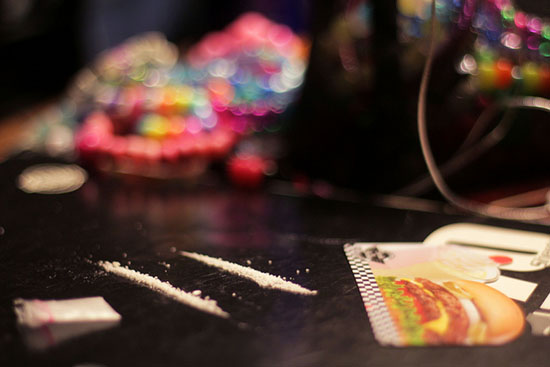The Trouble with Molly
Drug was used in spate of overdoses, fatalities

A series of recent overdoses—three of them fatal—attributed to the club drug MDMA, known as molly, has raised new concerns about its potentially lethal consequences.
Late last month, three people at the House of Blues in Kenmore Square overdosed on the drug, a purportedly pure powdered form of 3, 4-methylenedioxy-N-methylamphetamine, the active ingredient in ecstasy. One of the three, a 19-year-old student from Derry, N.H., died. Over Labor Day weekend, there were two more molly-related deaths, at a music festival in New York City, and three overdoses at a Bank of America Pavilion concert here in Boston.
Use of the drug appears to be on the rise. Government data show that the number of emergency room visits by people who had taken molly increased 123 percent from 2005 to 2009, the most recent year for which statistics are available. And the drug has become a popular topic among musicians, with artists Kanye West, Rick Ross, and Miley Cyrus referring to it in their songs.
The drug—popular because it creates feelings of euphoria and increased energy—is easy to get and relatively inexpensive, selling for $20 to $50 a dose. But the recent surge in deadly overdoses has law enforcement officials concerned that a bad batch of the drug is available in the Northeast.
Makers and sellers of the drug often cut it with dangerous substances such as amphetamines, cocaine, caffeine, and PCP. Anthony Pettigrew, a spokesman for the New England division of the Drug Enforcement Agency, recently told the Boston Herald that “there’s no good batch of molly, MDMA,or Ecstasy….you have no idea what’s in this stuff. Dealers want to make more money, so they’ll mix and adulterate the stuff with meth and any number of other drugs.”
The recent spate of overdoses has prompted the Boston University Police Department to post a fact sheet about molly and ecstasy to its website and Twitter account. Citing information compiled by the National Institute on Drug Abuse and NIDA for Teens, the fact sheet warns that the drug can cause anxiety and agitation as well as depression. Users are vulnerable to dehydration, particularly if they’re in a space where temperatures are high. Molly can also interfere with the body’s ability to regulate temperature, leaving those taking it at risk of developing hypothermia.
BU Today spoke about molly with David Farb, a School of Medicine professor and chair of the pharmacology and experimental therapeutics department.

BU Today: What exactly is molly?
Farb: Molly is just a new name for MDMA, but there are some designer drugs and additives that may be part of the substance.
How does the drug work in the brain?
It increases serotonin and dopamine levels in the limbic system.
Is there a way to quantify how dangerous the drug is?
One would have to define “dangerous,” but the cluster of recent cases of overdoses and deaths suggests that there is something bad about the batch that’s going around. It could, of course, be mixed with something that increases risk (MDMA plus methamphetamine would be a bad combination). Or maybe the MDMA dose is just unusually high.
Is the fact that molly is often cut with other substances—e.g., crystal meth or cocaine—one of the reasons it can be deadly?
Yes. If MDMA is combined with other drugs in the formulation known as molly, rather than pure MDMA, it can have more adverse side effects.
How addictive is it?
The addictive potential hasn’t been demonstrated.
You’ve said that any use of this drug constitutes drug abuse. Can you explain that?
The use of a drug for purposes other than therapeutics is ill-advised, and in particular, using a drug for the purpose of inducing an altered state of consciousness without being under the care and advice of a physician, i.e., obtaining the drug illegally, is abuse of the drug.
What symptoms would indicate someone is in danger of overdosing?
Severe adverse reactions to MDMA are generally attributed to hyperthermia. Dehydration and physical exertion—for example, dancing—in an overheated environment and/or exposure to diuretics (alcohol and caffeine) can exacerbate it. Serotonin syndrome (which includes hyperthermia among its symptoms) is a known, if uncommon, idiosyncratic effect of drugs that increase serotonin.
This BU Today story was written by John O’Rourke. He can be reached at orourkej@bu.edu.